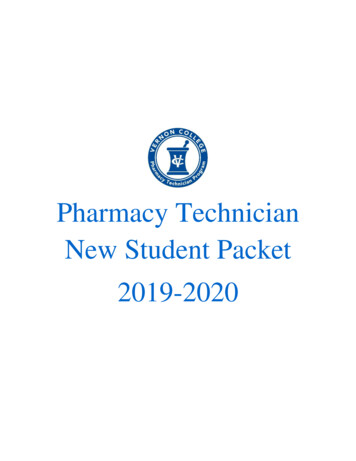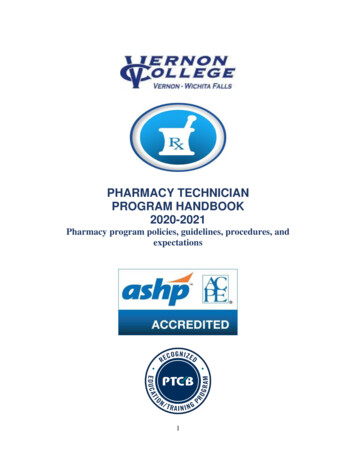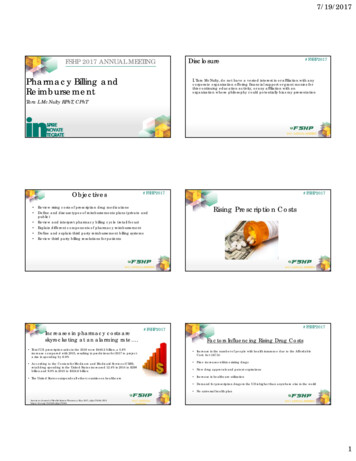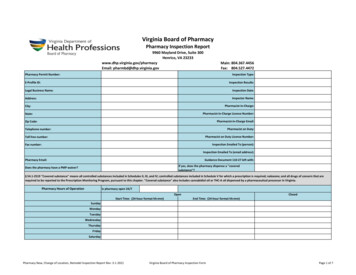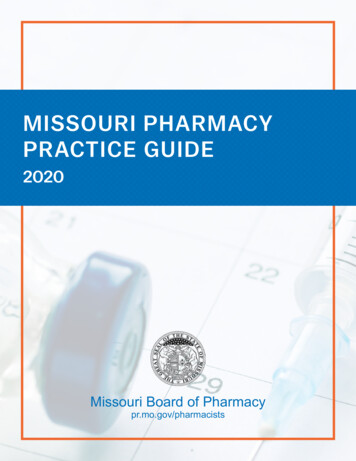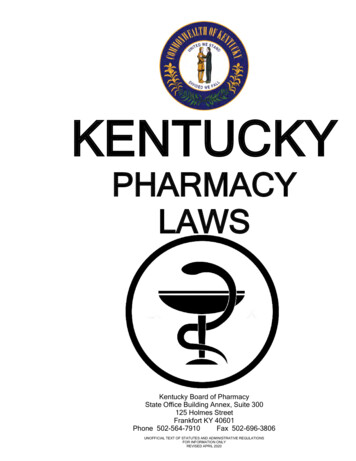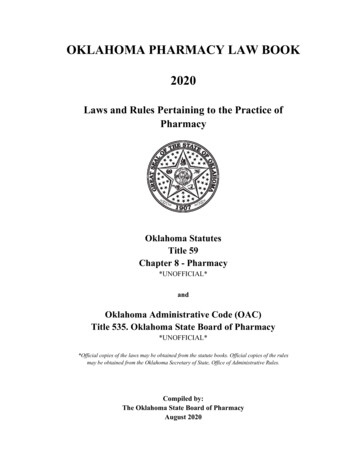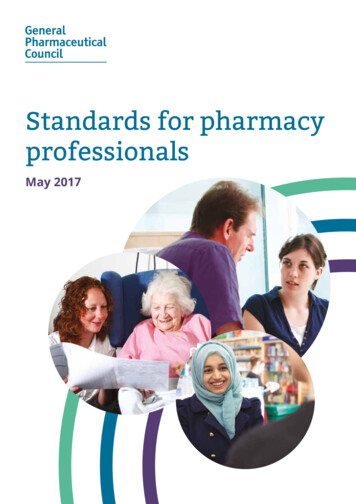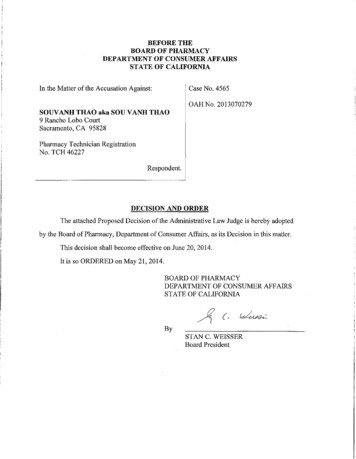
Transcription
BEFORE THEBOARD OF PHARMACYDEPARTMENT OF CONSUMER AFFAIRSSTATE OF CALIFORNIAIn the Matter of the Accusation Against:Case No. 4565OAHNo. 2013070279SOUVANH THAO aka SOU V ANH THAO9 Rancho Lobo CourtSacramento, CA 95828Pharmacy Technician RegistrationNo. TCH 46227Respondent.DECISION AND ORDERThe attached Proposed Decision of the Administrative Law Judge is hereby adoptedby the Board of Pharmacy, Department of Consumer Affairs, as its Decision in this matter.This decision shall become effective on June 20, 2014.It is so ORDERED on May 21, 2014.BOARD OF PHARMACYDEPARTMENT OF CONSUMER AFFAIRSSTATE OF CALIFORNIABySTAN C. WEISSERBoard President
BEFORE THEBOARD OF PHARMACYDEPARTMENT OF CONSUMER AFFAIRSSTATE OF CALIFORNIAIn the Matter of the Accusation Against:Case No. 4565SOUVANH THAO aka SOU VANH THAOSacramento, California 95828OAH No. 2013070279Pharmacy Technician RegistrationNo. TCH 46227Respondent.CORRECTED PROPOSED DECISION1On March 26, 2014, Gloria Megino Ochoa, Administrative Law Judge, Office ofAdministrative Hearings, State of California, heard this matter.Kent D. Harris, Deputy Attorney General, Department of Justice, represented VirginiaHerold, Executive Officer of the Board of Pharmacy (Board), Department of ConsumerAffairs (complainant).Respondent, Souvanh Thao, aka Sou Vanh Thao, represented himself.The hearing concluded on March 26, 2014. The record was kept open until close ofbusiness on March 28, 2014, upon applicant's request to submit documentary evidence in theform of letters relating to respondent's character and rehabilitation. On March 28, 2014,respondent submitted 13 letters, which were marked collectively as exhibit A and admittedinto evidence as administrative hearsay. Complainant's response to the evidence wasreceived on March 28, 2014 and was marked as exhibit 6. The record was closed and thematter was submitted on March 28, 2014.IIII1The Administrative Law Judge, on her own motion, issued this Corrected ProposedDecision to correct a typographical error in line 4 of Legal Conclusion 13, highlighted inbold. (Gov. Code,§ 11518.5, subdivision (d).)1
FACTUAL FINDINGS1.On March 6, 2003, the Board issued Original Pharmacy TechnicianRegistration Number TCH 46227 to respondent Souvanh Thao. The registration is in effectuntil April30; 2014. The Board has not taken any disciplinary action against respondentsince the license was originally issued in 2003.2.Complainant filed the Accusation in her official capacity on June 10, 2013.The Accusation charges that respondent is subject to disciplinary action under Business andProfessions Code section 4301, subdivision (1), in that respondent was convicted of a crimesubstantially related to the qualifications, functions, and duties of a licensee; and thatrespondent is subject to disciplinary action under Business and Professions Code section4301, subdivision (f), in that the conduct underlying the conviction demonstrated thatrespondent committed an act of moral turpitude.3.Respondent timely filed a Request for Hearing pursuant to Government Codesections 11504 and 11509. The matter was set for an evidentiary hearing before anAdministrative Law Judge of the Office of Administrative Hearings, an independentadjudicative agency of the State of California, pursuant to Government Code section 11500,et. seq.Conviction for Felony Assault with a Deadly Weapon4.Ou JuntJ 28, 2012, in lhtJ SuptJrior Cuurl u thtJ State uf California, County ofSacramento, after a jury trial, respondent was convicted of violating section 245, subdivision(a)(l) of the Penal Code (assault with a deadly weapon), a felony, and the lesser includedoffense under section 242 of the Penal Code (simple battery), a misdemeanor. Respondentwas sentenced to serve210 days in Sacramento County Jail (Sheriffs Work Project) for thefelony conviction and a concurrent 90 days in county jail for the misdemeanor conviction.However, upon the recommendation made in the probation report, respondent did not servehis sentence in county jail; he was instead placed under house arrest for 90 days, permitted toleave only to go to work and return home. Respondent was ordered to pay fines and fees. totaling 4,569.78 (which includes fees of 3,175 for legal services provided by the PublicDefender) and 46 per month for probation supervision. Respondent was also sentenced to 5years formal probation, which will end in June, 2017 unless terminated earlier.5.The circumstances surrounding the crime of which respondent was convictedwere as follows. On March 12, 2011, respondent and some friends and family memberswere celebrating a nephew's birthday at a bowling alley in Elk Grove, California. Accordingto the police officers responding to the call for law enforcement, there were several groupsfighting when they arrived. One report stated that "[t]here were hundreds of subjects insideyelling, screaming, and attempting to flee towards the exits." Respondent witnessed hisbrother get hit with a glass drinking cup and fall to the ground. Respondent rushed to his. brother and grabbed the person who hit his brother by the collar. When the person (thevictim) got away from him, respondent gave chase. Others were also chasing the victim,who was by then trying to flee across the bowling lanes. Respondent chased the victim2
across six or seven lanes, when the victim fell, and so did respondent. Respondent saw abowling ball rolling towards him, picked it up and threw the ball at the victim, who wastrying to get up. Another person (respondent's nephew) also threw balls at the victim.Respondent heard screams saying that someone was coming back into the bowling alley witha gun. He got up and picked up another ball which he again threw at the victim. The policeofficers on site called for an ambulance when the victim "appeared to be going in and out ofconsciousness." There is no further record of injury to the victim caused by the incident atthe bowling alley.6.At the hearing, respondent appeared quite remorseful, even in tears, andacknowledged, just as he did to the jury, that he was too aggressive in defending his brother,and should not have used bowling balls as weapons to fight the victim. When asked why hecontinued to chase after the victim after he got the victim to leave his brother alone,respondent replied that he chased after the victim because he (respondent) "did not knowwhat was going on" at the scene. When asked if he thought it was wrong to attack someonewhen that person was already down on the floor, respondent replied that he agreed it waswrong, but that at the time, he had heard someone yelling that someone was coming backwith a gun, and that was when he took the second bowling ball and threw it at the victim.Respondent repeatedly acknowledged he had done wrong, he was too aggressive, and he wassorry for what he had done.7.Respondent successfully served his county jail sentence through house arrest,with permission to go to and from work daily, for 90 days. He is now on probation, subjectto all of the general probation terms and conditions imposed by the court. Although he wasnot ordered to undertake any training or counseling, respondent sought guidance from theBoard but was told there were no programs, classes, or training available for pharmacytechnicians(though there were for pharmacists). Respondent stated his willingness to attend"anger management" classes if given the opportunity to maintain his license as a pharmacytechnician. No evidence was presented as to whether the fees and fines imposed by the courthave been or are being paid. Respondent's probation will last until June 2017, unless earlierterminated by the court.Factors in Mitigation and Rehabilitation8.In order to determine whether to grant or discipline a professional license, thefinder of fact should consider the conduct of the licensee and any factors introduced injustification, mitigation, aggravation and rehabilitation. "The licensee, of course, should bepermitted to introduce evidence of extenuating circumstances by way of mitigation orexplanation, as well as any evidence of rehabilitation." (Arneson v. Fox (1980) 28 Cal.3d440, 449; Brandt v. Fox (1979) 90 Cal.App.3d 737, 747.)9.There were no factors in justification or aggravation presented. There arehowever factors in mitigation and rehabilitation to be considered. Respondent came to theUnited States 30 years ago when he was six years old, and has lived in Sacramento for thepast 22 years. The sixth of 12 children, respondent married his high school sweetheart at age3
21, put her through nursing school by constructing window frames, and when she wasfinished with school, undertook the training to become a pharmacy technician. He comesfrom a family that respects education and its potential as a tool for economic advancement,and has two siblings who are social workers and another, a police academy graduate.Married for 14 years, respondent and his wife have twin girls and a baby born in February2014. Respondent has worked continuously as a pharmacy technician for 11 years andthroughout the prosecution of his criminal case, and hopes to continue working in thatcapacity if allowed to do so. Until the incident that resulted in his criminal convictions,respondent had no police record of any kind.10.Respondent presented Cher Yang, his wife, as a character witness. Ms. Yangbelieves that respondent believed he was defending his brother when he attacked the victimat the bowling alley, and that he was carried away "in the heat of the inoment" because of hisstrong ties to his brother. Ms. Yang described respondent's devotion to his work whileputting her through nursing school, and his subsequent determination to complete his owntraining so he may work as a pharmacy technician. She has worked for UC Davis MedicalCenter for eight years as an oncology nurse, and is currently on maternity leave. Ms. Yangdescribed her husband as a kind, good person, an upstanding citizen who made one bigmistake in his life.11.Copies of numerous letters, written on behalf of respondent and addressed tothe judge presiding over his criminal case, were submitted by respondent after the hearing tosupport his claims of good character, and were considered to the extent permitted byGovernment Code section 11513, subdivision ( d). 2 While most of the letters were dated inJuly 2012, there was unanimity in describing respondent as someone who" has never been introuble with the law," "who knows what is right and wrong," "who works well with others,""is dedicated to his work as well as family," "hardworking, a family man who is community minded and other-centered.'' It is Clearthat air l the fetter writers were aware oflhe- criminal conviction, and were in support of a lenient sentence for respondent. One letterspoke to respondent's active involvement in many Hmong community functions and histrustworthiness; another recounted his good sportsmanship, leadership skills, and hisdedication as a mentor to many of the younger players on his soccer team. There were acouple of letters from respondent's instructors, who endorsed his skills as a pharmacytechnician as well as a person who is reliable, responsible, hardworking, and team oriented.A co-worker who is a licensed pharmacist said that respondent "has always been a full teamplayer: taking on new tasks, proficiently completing all jobs assigned, exhibiting flexibilitywhen staffing shortages arose, and maintaining a professional attitude, attention to detail, andcivility to customers and coworkers alike." Finally, respondent submitted a letter from hiseldest brother, a social worker at the Sacramento County Department of Health and HumanServices, that extolled respondent's role as a leader in the Hmong community as well as a2Government Code section 11513, subdivision (d) states in pertinent part, "Hearsayevidence may be used for the purpose of supplementing or explaining other evidence butover timely objection shall not be sufficient in itselfto support a finding unless it would beadmissible over objection in civil actions ."4
beloved member of their family, and from his brother in law, Cher Yang's brother, who said,"[w]ithout Sou Vanh's support, I know my sister will not be where she is today, a registerednurse and mother of two. Unfortunately, Sou Vanh's supportive nature is also what got himinto this situation. He came to the support of his brother who was brutally assaulted. SouVanh's actions that occurred after coming to the aid of his brother do not reflect the person Ihave known for the past 13 years. He is not a violent person, it was a lapse in judgment andone that I know if he had to do again, he would do differently."Respondent's Scope of Work12.Complainant presented an expert witness who performs complianceinspections and investigations of criminal convictions of licensees. The witness, a licensedpharmacist since 1981, described the primary duties of a pharmacy technician registrant:order and receive drugs, put away the drugs, check prescriptions, create the labels for theprescribed drugs, and interact with the public in retail pharmacy settings. He stated thatregistered pharmacy technicians do not interact with the public in hospital settings, nor inskilled nursing facility pharmacies, nor in closed door pharmacies. "Closed doorpharmacies" are those where neither patients nor the public go to fill prescriptions, i.e., thereis no contact between the pharmacy technicians and the public or the patients. Pharmerica,where respondent has worked for 11 years (since 2003, when he received his license), is aclosed door pharmacy.13.Respondent described his job duties at Pharmerica as involving only dataentry: when a prescription is received or called in, respondent types all the informationneeded on the labels for the medication, while other technicians ready the medicationaccording to the prescription, and yet others actually place the medication into theappropriate container. Respondent does not handle any duties such as ordering or receivingdrugs from the company's wholesale suppliers. While at work, respondent does not interactwith any member of the public, nor does he handle any medications or drugs. It is not clearfrom the letters submitted by respondent's co-workers at Pharmerica whether or not hisemployer has been informed of his criminal convictions. However, respondent hascontinuously worked at Pharmerica until the present date.Request for Recovery of Costs14.Pursuant to Business and Professions Code section 125.3, complainant hasrequested recovery of the reasonable costs of the investigation and enforcement of this case,which is the total sum of 1,657.50. At the hearing, the Board's counsel Deputy AttorneyGeneral Kent D. Harris introduced a declaration dated March 18, 2014 to which was attacheda detailed statement detailing the hours that were spent by various professionals, includingMr. Harris, on enforcement of the case and preparation for the hearing. Respondent did not ·object to the requested sum, nor did he establish a basis to reduce or eliminate the costs inthis matter. In the absence of evidence to the contrary, the claimed costs of 1,657.50 arefound to be reasonable.5
LEGAL CONCLUSIONSApplicable Statutes and Regulations1.Section 118, subdivision (b) ofthe Business and Professions Code providesthat the expiration of a license shall not deprive the Board of jurisdiction to proceed with adisciplinary action during the period within which the license may be renewed, restored,reissued, or reinstated. As set forth in Finding 1, Pharmacy Technician Registration No.TCH 46227 expires on April30, 2014, and is subject to renewaL2.Business and Professions Code section 4301, subdivisions (f) and (1), state:The board shall take action against any holder of a license whois guilty of unprofessional conduct or whose license has beenprocured by fraud or misrepresentation or issued by mistake.Unprofessional conduct shall include, but is not limited to, anyof the following:[ ]. [ ](f) The commission of any act involving moral turpitude,dishonesty, fraud, deceit, or corruption, whether the act iscommitted in the course of relations as a licensee or otherwise,and whether the act is a felony or misdemeanor or not.(l) The conviction of a crime substantially related to thequalifications, functions, and duties of a licensee under thischapter. The record of conviction of a violation of Chapter 13(commencing with Section 801) of Title 21 of the United StatesCode regulating controlled substances of dangerous drugs shallbe conclusive evidence of unprofessional conduct. In all othercases, the record of conviction shall be conclusive evidence onlyof the fact that the conviction occurred. The board may inquireinto the circumstances surrounding the commission of the crime,in order to fix ,the degree of discipline or, in the case of aconviction not involving controlled substances or dangerousdrugs, to determine if the conviction is of an offensesubstantially related to the qualifications, functions, and dutiesof a licensee under this chapter. A plea or verdict of guilty or aconviction following a plea of nolo contendere is deemed to be aconviction within the meaning of this provision. The board maytake action when the time for appeal has elapsed, or thejudgment of conviction has been affirmed on appeal or when an6
order granting probation is made suspending the imposition ofsentence, irrespective of a subsequent order under Section1203.4 of the Penal Code allowing the person to withdraw his orher plea of guilty and to enter a plea of not guilty, or settingaside the verdict of guilty, or dismissing the accusation,information, or indictment.3.California Code of Regulations, title 16, section 1770, states that, "[f]or thepurpose of denial, suspension, or revocation of a personal or facility license pursuant toDivision 1.5 (commencing with Section 475) of the Business and Professions Code, a crimeor act shall be considered substantially related to the qualifications, functions or duties of alicensee or registrant if to a substantial degree it evidences present or potential unfitness of alicensee or registrant to perform the functions authorized by his license or registration in amanner consistent with the public health, safety, or welfare."Substantially Related Criminal Conviction4.As set forth in Findings 1 through 6 and Legal Conclusions 1through 3,respondent's criminal convictions are substantially related to the qualifications, functions andduties of a pharmacy technician registrant within the meaning of California Code ofRegulations, title 16, section 1770, in that the crimes of assault with a deadly weapon andsimple battery committed by respondent show, to a substantial degree, his present orpotential unfitness to perform the functions authorized by his registration in a mannerconsistent with the public health, safety, or welfare. In this case, respondent chased a personacross several lanes at a bowling alley and then, after the person fell down, threw bowlingballs at him. The potential for grave injury to that person was present, and the fact that theperson was not severely injured was simply due to providence. The crimes of whichrespondent was convicted, by definition, are inconsistent with laws governing the protectionof the public health, safety or welfare.Licensees in the health care industry are required to abide by numerous laws andregulations established to protect the health and safety of the public. This includes abidingby laws that govern the licensee's activities that may not be directly related to his or herprofessional license, but could impact the public's health and safety outside the workenvironment. Respondent has demonstrated a terrible lapse of judgment in assaulting aperson who had already fallen down and was struggling to get up and away from him, andattacking with a bowling ball which could have inflicted deadly force on his victim. Aperson who commits an act of violence poses a risk to the health, safety and welfare of thepublic. The act of violence of which respondent was convicted showed a dangerousvolatility and a conscious and selfish disregard for the law and the rights of others. (In reGossage (2000) 23 Cal. 4th 1080, 1098, citing In reNevill (1985) 39 Cal.3rd 729,735 and Inre Strick (1987) 43 Cal3rd 644, 653.)II7
Acts ofMoral Turpitude5.Under Business and Professions Code section 4301, subdivision (f), cause forsuspension or revocation of a pharmacy technician registration due to unprofessional conductis established if respondent committed an act of "moral turpitude .whether the act iscommitted in the course of relations as a licensee or otherwise, and whether the act is afelony or misdemeanor or not."In Jordan v. De George (1951)341 U.S. 223, the Supreme Court defined "moralturpitude" as conduct so far contrary to the moral law, as interpreted by the general moralsense of the community, that the offender is brought to public disgrace, is no longergenerally respected, or is deprived of social recognition by good living persons. Moralturpitude has also been defined as an act which is per se morally reprehensible andintrinsically wrong, or malum in se, so it is the nature of the act itself and not the statutoryprohibition of it which renders a crime one of moral turpitude. (Cuevas-Gaspar v. Gonzales,430 F.3d 1013, 1018 (9th Cir.2005), also citing Carr v. INS, 86 F.3d 949, 950-51 (9thCir.1996), which notes that assault with a deadly weapon is not necessarily a crime involvingmoral turpitude.)In terms of the practice of a profession, a crime of moral turpitude has also beendefined as criminal conduct that "involves a serious breach of a duty owed to another orsociety, or such a flagrant disrespect for the law or for societal norms, that knowledge of theconduct would likely undermine the public confidence in and respect for the profession." Inre Stuart K. Lesansky (2001) 25 Cal. 4th 11, 16.The case of People v. Cavazos (1985) 172 Cal.App.3d 589 addresses crimes of moralturpitude as they apply to a licensee's fitness to practice under his or her license. In Cavazos·the court applied the Supreme Court holdings on assault with a deadly weapon cases toformulate a standard by which to determine an attorney's fitness to continue his practice."Simple fairness requires the court to look behind the conviction to ascertain the precisenature of the assault and the circumstances in which it occurred. The bare fact of convictiondoes not determine the attorney's fitness to practice." (People v. Cavazos, supra, at p. 595.)In this case, it is appropriate to examine respondent's fitness to practice his pharmacytechnician registration.6.Respondent's act of throwing bowling balls at a person who had fallen down isconduct that could subject that person to potentially great bodily harm, thus constituting abreach of a duty owed by respondent to that person. Under Business and Professions Codesection 4301, subdivision (f), respondent committed an act of moral turpitude, even thoughthe act was not committed in the course of his work as a pharmacy technician registrant.IIII8
Cause for Discipline7.As set forth in Findings 1 through 6 and Legal Conclusions 1 through 4, causefor suspension or revocation of respondent's pharmacy technician registration wasestablished by clear and convincing evidence, pursuant to Business and Professions Codesection 4301, subdivision(!), in that respondent was convicted of crimes that aresubstantially related to the qualifications, functions, and duties of a pharmacy technicianregistrant.8.As set forth in Findings 1 through 6 and Legal Conclusions 1, 2, 3, 5 and 6,cause for suspension or revocation of respondent's registration as a pharmacy technician wasestablished by clear and convincing evidence, pursuant to Business and Professions Codesection 4301, subdivision (f), in that that he has committed an act or acts of moral turpitude.Disciplinary Considerations9.California Code of Regulations, title 16, section 1769, subdivision (b) states:(b) When considering the suspension or revocation of a facilityor a personal license on the-ground-that-the-licensee-or-theregistrant has been convicted of a crime, the board, in evaluatingthe rehabilitation of such person and his present eligibility for alicense will consider the following criteria:(1) Nature and severity of the act(s) or offense(s).(2) Total criminal record.(3) The time that has elapsed since commission of the act(s) oroffense(s).(4) Whether the licensee has complied with all terms of parole,probation, restitution or any other sanctions lawfully imp(Jsedagainst the licensee.(5) Evidence, if any, of rehabilitation submitted by the licensee.10.California Code of Regulations, title 16; section 1760, states:In reaching a decision on a disciplinary action under theAdministrative Procedure Act (Government Code section 11400et seq.) the board shall consider the disciplinary guidelinesentitled "Disciplinary Guidelines" (Rev. I 0/2007), which arehereby incorporated by reference.9
Deviation from these guidelines and orders, including thestandard terms of probation, is appropriate where the board, inits sole discretion, determines that the facts of the particular casewarrant such a deviation-the presence of mitigating factors; theage of the case; evidentiary problems.11.The board's Disciplinary Guidelines list the following factors to be consideredin determining penalties:Section 4300 of the Business and Professions Code providesthat the board may discipline the holder of, and suspend orrevoke, any certificate, license or permit issued by the board.In determining whether the minimum, maximum, or anintermediate penalty is to be imposed in a given case, factorssuch as the following should be considered:1.actual or potential harm to the public2.actual or potential harm to any consumer3.prior disciplinary record, including level of compliancewith disciplinary order(s)4.prior warning(s), including but not limited to citation(s)and fine(s), letter(s) of admonishment, and/or correctionnotice(s)5.number and/or variety of current violations6.nature and severity of the act(s), offense(s) or crime(s)under consideration7.aggravating evidence8.mitigating evidence9.rehabilitation evidence10.compliance with terms of any criminal sentence, parole,or probation11.overall criminal record10
12.if applicable, evidence of proceedings for case being setaside and dismissed pursuant to Section 1203.4 of thePenal Code13.time passed since the act(s) or offense(s)14.whether the conduct was intentional or negligent,demonstrated incompetence, or, if the respondent isbeing held to account for conduct committed by another,the respondent had knowledge of or knowinglyparticipated in such conduct15.financial benefit to the respondent from the misconduct.No single one or combination of the above factors is required tojustify the minimum and/or maximum penalty in a given case,as opposed to an intermediate one.12.Applying the board's rehabilitation criteria in this matter, it has been a littleover three years since the events giving rise to the convictions took place. The violationresulted from a single act of misconduct. In sentencing respondent to 210 days in county jailwith a concurrent sentence of 90 days, and then allowing respondent to serve the concurrentsentences by imposing house arrest with work furlough, the court acknowledgedrespondent's criminal history (showing no record of arrests or convictions whatsoever), therecommendations of the probation report, and the likelihood that respondent poses no risk ofharm to the public. Respondent has successfully served his sentence of house arrest withwork furlough, and has served almost two years of his five-year formal probation sentencewithout incident. Respondent's probationary period will end in June, 2017, unlessterminated earlier by the court.13.In mitigation, respondent has repeatedly taken responsibility for his actions,though he had cause to believe that at the time of the incident there could have been furtherdanger to himself or to his brother. Respondent has not been the subject of any priordisciplinary actions or warnings from the board. As set forth in Finding 5, the convictionsresulted from a single act of misconduct, during a singular incident unlikely to reoccur. Asset forth in Findings 8 through 11, respondent is a consistently responsible member of hisfamily and community, as well as an exemplary co-worker. Respondent has continuouslyworked at Pharmerica, his one and only employer since he was granted a pharmacytechnician registration. As set forth in Findings 12 and 13, respondent's duties at his presentemployment do not entail contact with members of the public or with patients requiringmedication.14.Under all of the circumstances herein, the evidence established that respondentcan retain his registration as a pharmacy technician at this time without harm to the public,with appropriate terms and conditions of probation.11
15.Respondent indicated during his testimony that he would be willing to takeanger management classes, in recognition of his inappropriate and aggressive response to theincident that resulted in his criminal convictions. Under the Disciplinary Guidelines of theBoard of Pharmacy applicable to pharmacy technicians, respondent may be ordered to takean anger management training program as remedial training and a condition of probation.Costs16.Business and Professions Code section 125.3 provides, in pertinent part, thatthe Board may request the administrative law judge to direct a licentiate found to havecommitted a violation or violations of the licensing act to pay a sum not to exceed thereasonable costs of the investigation and enforcement of the case. Business and ProfessionsCode section 125.3, subdivision (c), states:(c) A certified copy of the actual costs, or a good faith estimateof costs where actual costs are not available, signed
Others were also chasing the victim, who was by then trying to flee across the bowling lanes. Respondent chased the victim 2 . across six or seven lanes, when the victim fell, and so did respondent. . Respondent heard screams saying that someone was coming back into the bowling alley with

